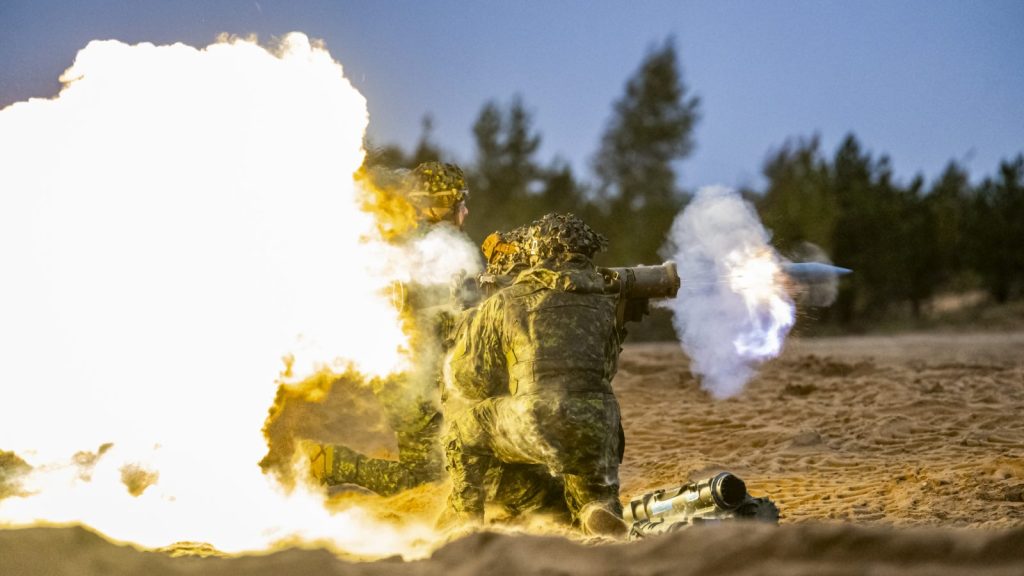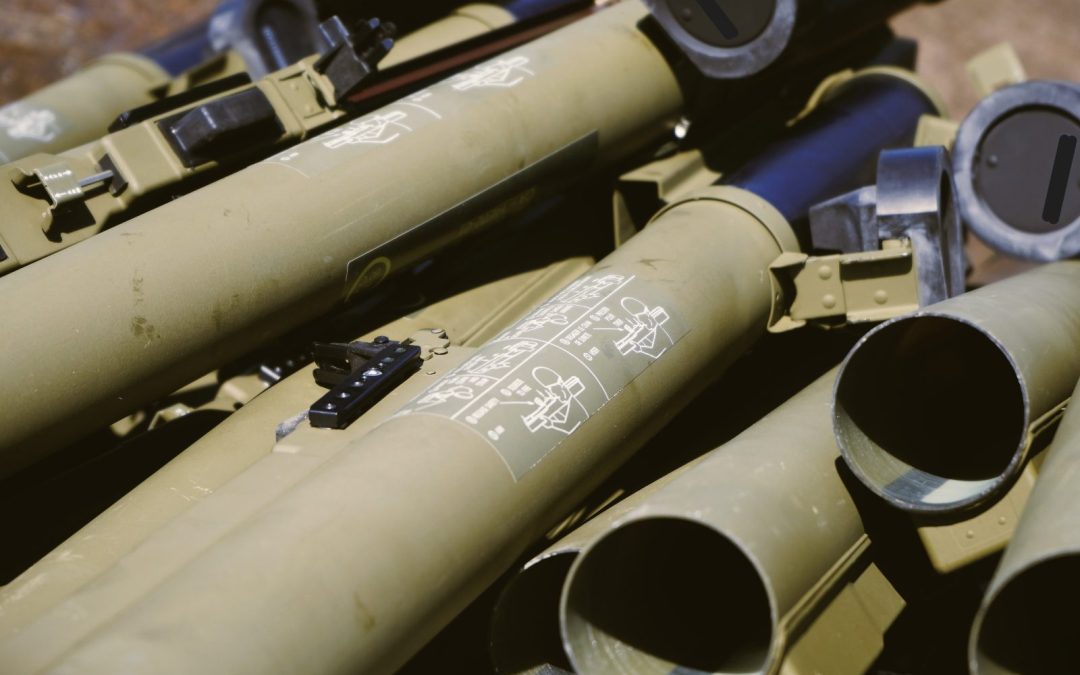Since February 2022, the Canadian government has provided over $2.4 billion in military assistance to Ukraine. Some equipment was specifically acquired for the Ukrainian military, but much has come from the stocks of the Canadian Army, including Leopard 2A4 main battle tanks, an armoured recovery vehicle, armoured combat support vehicles, M777 howitzers, anti-tank weapons, small arms, associated ammunition, personal protection, winter clothing, and more. What gets replenished, what gets replaced with newer capability, and when, falls in part on the Director General, Land Equipment Program Management (DGLEPM). Shortly before he was promoted to Chief of Staff for the Materiel Group this summer, Major-General Rob Dundon, former DGLEPM, spoke about the task of replenishing stocks while adjusting to a new capability sustainment model.
What’s the process for replenishing or replacing all this equipment, and how much of that lands on DGLEPM?
The first thing I’d say is that the Department of National Defence (DND) does not have a good system for exercising donations. It was never fundamentally designed that way, for a comprehensive program like this to aid another nation that’s in peril. And it has challenged our system, to say the least. The government seems to have a firm idea of where it wants to go. It’s more internally; we don’t necessarily have the policy mechanisms inside our own organization to do it. Where I get involved is where the rubber hits the road, with replacement primarily of a lot of the clothing, equipment, and lethal aid.
The scope of what we’re replacing is fairly large, to the tune of about $220 million. And some of it gets very challenging to replace. Some we don’t worry about, such as fragmentation vests that we were phasing out anyway. The more challenging ones are things like M777 howitzers. BAE Systems, the original manufacturer, is not planning on running a production line until 2028, until they have orders for 120 guns.
Tanks are a challenge, too. We’ve already got multiple variants. The Army used to have around 120 tanks in two fleets. There was a version of the Leopard 2A4 and the Leopard 2A4M, which had a mobility enhancement on it that required some different parts. Later we introduced a Leopard 2A6 and a Leopard 2A6M. And then there was an armored engineering vehicle and an armored recovery vehicle. So, in many ways we have six different variants inside the Army.
As we look internationally at replacing the tanks, you realize that KraussMaffei Wegman and Rheinmetall are not fabricating 2A4s anymore, nor are they fabricating 2A6s. You’ve got to now go to the Leopard 2A7. And there’s a movement afoot, primarily led by Germany, to get a group of NATO nations together to open up a production line for Leopard 2A8. That would introduce a seventh variant and possibly even an eighth if we put mobility enhancements on it. That becomes a challenge for us. We know the procurement mechanism by which we would do this, but we’re waiting for a call at the Canadian Armed Forces (CAF) level to see which way we want to go with tanks. Do we buy A7s? Do we get on the bandwagon with the A8 change? Do we go to another original equipment manufacturer? We’ve looked at all the options. We’re now waiting for a CAF strategy decision on which way they want us to execute.
At what point does replenishment become replacement? Not everything necessarily needs to be one-for-one and like-for-like. If the Army’s Indirect Fires Modernization program, for example, is looking at the next bound for long-range fires, do you still replenish the M777 stock?
Those are the types of decisions that we’re waiting for, and a lot of them haven’t been decided. You’re right, Indirect Fires Modernization is a massive program to lift us up to the next tier for indirect fires. Fundamentally the world has changed. The M777 is a great platform when you’re conducting counterinsurgency missions. But when it’s state-on-state, my preferences is to be under armour. The targeting cycle is down to three to four minutes right now. The Russian capability to find a target and engage it is like nothing we have ever seen. So, we’re looking at options for the full gamut: Loitering munitions, self-propelled howitzers, and even replenishment of the M777s.
Of the equipment that falls within your immediate remit, what are the priorities?
All ammunition that has been donated is programmed for replenishment out to 2028. We have a program with a five-year funding profile; we even know when they’re coming in. There is some de-mining equipment that we donated in the first tranche. We’re not necessarily looking at replacing it, as the technology has moved on, but we are ready to move forward with new technology. The same for fragmentation vests, where we are looking at Kevlar vests that are sized appropriately for women. Those are being incorporated into other projects that we’re doing in the future.
Carl Gustaf rocket launchers are another piece of equipment that isn’t fabricated anymore, so we are looking at more modern systems from multiple firms. The challenge we get into with ammunition is that we acquire all these through the munition supply program. There is a strategic Memorandum of Understanding agreement with five firms in Canada that we use to produce these munitions. And the regime to order is specific, so some of these will take three years to replace. There is a movement afoot to invest significantly in the munition supply program, to ramp up our production of 155 ammunition in particular, to the point that we are working with the United States to establish a North American industrial base, to augment what the Americans are doing. I can’t say much more than that, but we have already made one investment. We were producing 3,000 rounds a month, we’re now up to 5,000 rounds a month, and we’re looking at going well beyond that.
That said, we have never dipped into our strategic reserves or anything that we consider operationally necessary. As a consequence, we think we’re okay on all those.

Mechanized Infantry members of NATO enhanced Forward Presence Battle Group Latvia fire an 84mm Carl Gustav during an anti-armor exercise at Camp Ādaži, Latvia in October 2023. Photo: Cpl Lynette Ai Dang
How does the shift to Continuous Capability Sustainment impact DGLEPM? If you are continuously sustaining capability, are you by extension continuously procuring it? If you’re acquiring capability in regular spirals, are sustainment and procurement more integrated?
Interoperability, supply chain resilience, and Continuous Capability Sustainment all must integrate to be able to do what we’re trying to achieve. Continuous Capability Sustainment is about moving away from the standard approach of starting a project every time you buy something. The rationale being, when you start a project, you do so because you’ve been asked to do something new. At no point has the government ever asked us to stop moving, shooting or communicating. Really, all we want to do is be able to keep up with technology in those three regards. It’s a bit of tweaking. That entails transferring money from a Capital account over to an In-Service Support account. You improve your equipment through cycles of faster iteration. As opposed to doing a big buy, a midlife upgrade, and then disposing of it in 30 years, you are doing incremental change every three to four years.
We know fundamentally that single-use military equipment becomes obsolete in about eight years because adversaries figure out how to defeat it. We want to move to a faster cycle, because that’s really the essence of the Western way of war – technological overmatch. We’re going to do that through technology injections that are a bit cheaper and don’t require the authority levels that we go through with full project management. This is a concept that was developed in close collaboration with Public Service and Procurement Canada and Innovation, Science and Economic Development Canada.
Industry plays a really important role in all this. DND is not a cutting-edge leader in technology development, but our Canadian industrial base is, and they have the network and the know-how to do this. So, we need to develop more strategic partnerships. Fundamentally, what we need is a technology roadmap. I could figure out what a technology injection might look like in three years or five years, but when I get past that, I don’t necessarily know. But each of our Canadian firms has good research and development programs and they know where that technology can go. If we couple that with what Defence Research and Development Canada does, it will be a winning combination.
Do you need to move to a modular approach to do this? Industry might not always know what a fifth or sixth iteration of a technology is going to be, but if capability is delivered in modules, you might be able to swap out without too much disruption.
Precisely. You want to focus on modularity and inter-compatibility with the parts. They’ve got to be interchangeable to an unprecedented degree.
That ties into this emerging emphasis on interchangeability in addition to interoperability. What is driving that? And what does it mean for how you approach acquiring equipment?
I can speak specifically about one instance that resonated with me and changed my mind about interoperability. Nine different nations contributed M777s to Ukraine, which were all supposed to be common systems. But then 14 different natures of 155-millimeter ammunition came with those. All the western nations had qualified their guns with very specific ammunition that we thought was interoperable. And Ukrainian logisticians are struggling as a result — they have got to match up the gun that’s on the frontline with the ammunition from the nation that donated it. We learned a hard lesson at their expense that we are probably not as interoperable as we thought inside NATO.
Incidents like this sparked the Committee of National Armaments Directors — they have been meeting on a frequent basis since the invasion of Ukraine — to look at ways to move beyond interoperability, to define what the next level is going to be. The term that they’ve settled on is one that you’re just starting to hear, interchangeability. What it really means is, this type of incident with the M777 will never happen in the future. Armed forces from one nation will be able to use the equipment of another nation without any type of challenge. We want to get to the point where a Spanish soldier can pick up a Canadian anti-tank system, she may not be able to read the language, but she has a good feeling for how the buttons work, how to aim it and make it function. Or an American who has no experience on one of our radios can see it’s comparable to something that he’s used, and make it function.
Does that mean a rethink around NATO standards? We’ve assumed that STANAGS provide for a degree of interoperability. Do you now need a much more general standard?
We have teams looking at that. We don’t know what the new standard is ultimately going to look like, but what we are finding is that we’re going to have to look seriously at strategic partnerships with other nations, that everybody understands these broader standards of interchangeability and what that will fundamentally mean. What that could entail for communication systems, for example, is open architecture software, common waveforms for the ability to communicate with all these systems, and more common standards on user interfaces.

A Leopard 2 Main Battle Tank moves into position during Exercise Maple Resolve 2023 in May. Photo: Cpl Michael Turner
From a Canadian standpoint, does that mean more commercial or military off-the-shelf capabilities? Perhaps a greater inclination to follow the lead of others if they’ve already acquired and certified a piece of equipment?
Your instinct is right. If another nation qualifies a weapons system and then we buy it military-off-the-shelf, it accelerates our acquisition cycle and ensures we are getting the same type of equipment. But there’s always a risk doing that. There is a desire to meet interchangeability, but we’ve got to balance that against the risk of things like vendor lock, where you’re so embedded with a contractor that they’re not innovating. That’s why Canadian policy around competition has always been so important to what we do. That focus on competition forces a degree of innovation amongst Canadian firms that makes us world leaders for some of the capabilities we produce.
Do you become a little more reliant on industry centers of excellence as repositories of certain key capabilities that can be delivered more quickly?
You do become more dependent on them. But again, you’ve got to balance that with that need for innovation and ensuring small and medium enterprises with cutting edge technology can play in the game, because you don’t want to see a monopoly develop. And that’s where my role comes in. What my team and I do is try to be sophisticated customers, making sure that we’re achieving that balance.
We can’t necessarily dictate that large firms go to the small and medium enterprises for subcontractors. But we want to encourage that type of thing, to help bring them inside the tent. We’ve had great success with Logistik Unicorp. This is a prime example of one we have been working on for years. We’ve asked them to find some great technology and show us how to advance what we’re trying to do. For example, to go out and source natural products. They’re now experimenting with milkweed as insulation in our jackets. They have teamed up with indigenous firms to harvest it. Clothing and equipment are a little bit easier than trying to do the same thing with a light armored vehicle, but we’re seeing other firms be very responsive.
If you’re building strategic partnerships with specific firms or clusters, does that in turn ensure greater supply chain resilience? Does continuous engagement like that lead to resilience in and of itself?
It does. Don’t get me wrong, we’ve been continuously engaged with all these firms. But we’re talking about more than that. When we looked at our ammunition manufacturing capability, for instance, we have great resources in Canada. But when you start looking for the explosive component that gets poured into each of these shells, we realized that we don’t control the whole supply chain to be able to fabricate that. We don’t even control the supply chain to be able to fabricate a 5.56mm round completely without having to reach outside Canada.
So, we’re looking deeply at many of our supply chains, and the pedigrees of components that go into all our manufactured goods, and making sure we definitively know where they are coming from. We can’t necessarily have everything in Canada, it just doesn’t make sense. You can get better prices on a competitive market. But what we are looking at is friend-shoring, making sure that we have partners across the globe that are reliable and trustworthy. That’s really what supply chain resilience is about — those strategic friend-shoring partnerships.
The Army has trialed a third-party cloud-based network service on Exercise Maple Resolve, and the modernization strategy encourages exploring the Everything as a Service model. How widely and how far forward can you project that approach?
There’s a challenge with Functions-as-a-Service in that they can only go so far forward. Life insurance firms just aren’t going to cover anybody going into the Ukraine — it is considered a war zone — so we must carefully select how far forward we go with them.
We’re experimenting right now with project management as a service for some of our communications components. The Royal Canadian Corps of Signals is really struggling with human resources, so I can’t draw on many of their communications-electronics engineers. We’re looking at a model that the American Army has used, where they have entered into an agreement with an organization to do project management as a service. We’re about to attempt the same thing. For Army equipment, this is our first foray with project management as a service, and it’s a sensitive issue. You want to make sure that any firm that has the potential to win this contract is not also producing the radios, building the antennas, or making the batteries, because it quickly becomes a conflict of interest.
The world has changed. State-on-state warfare has made a comeback. We are moving to deterrence, and that is fundamentally changing the way that we look at everything, including our equipment and our systems and processes to deliver that. That’s what you’re seeing here. You’re seeing all this in the background, and we’re trying to weave it together into one big strategy.




